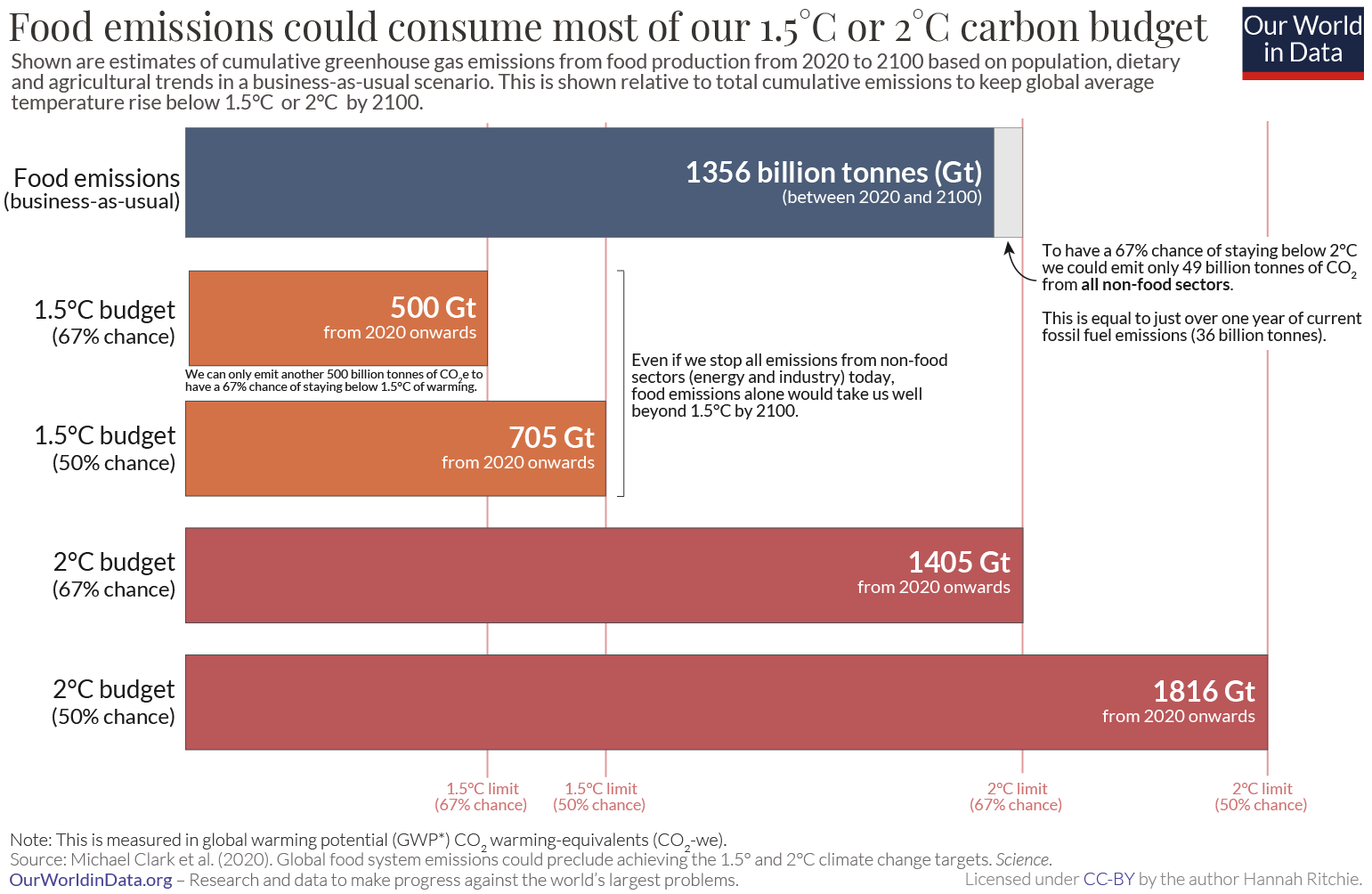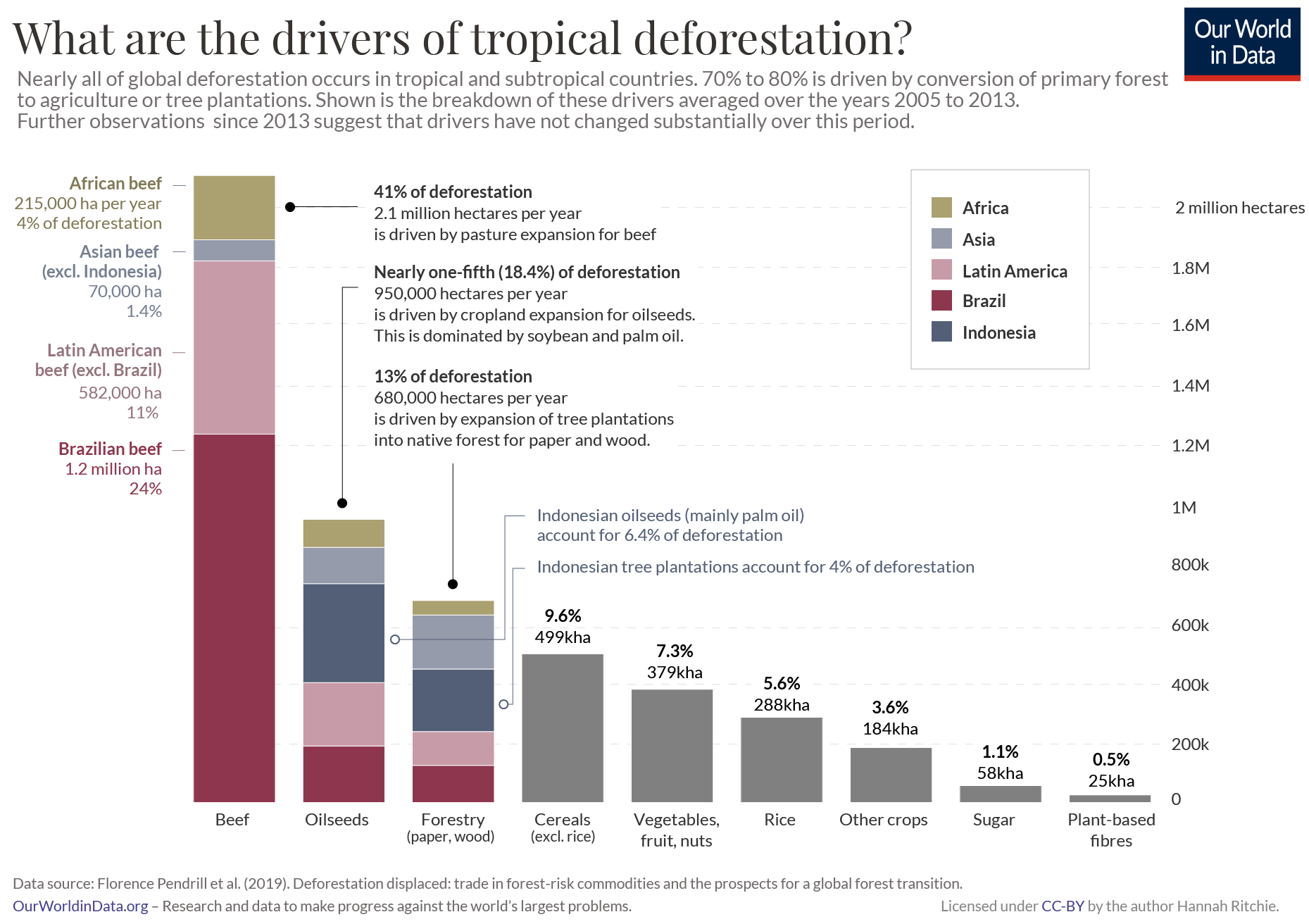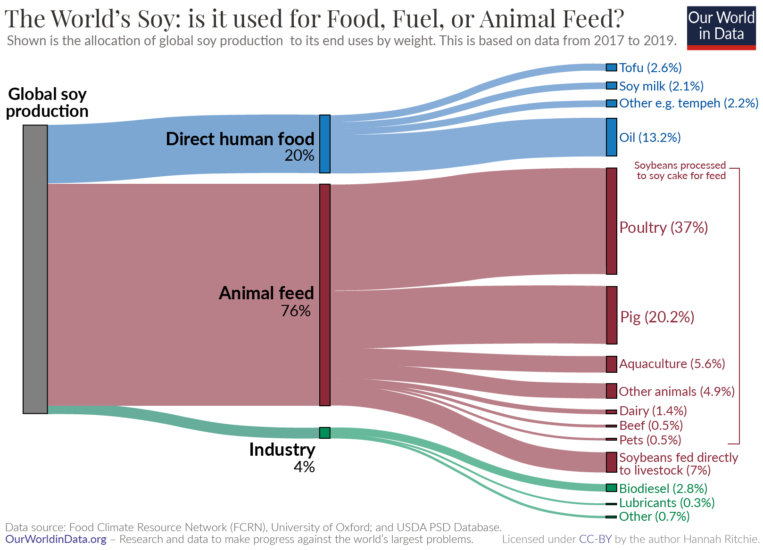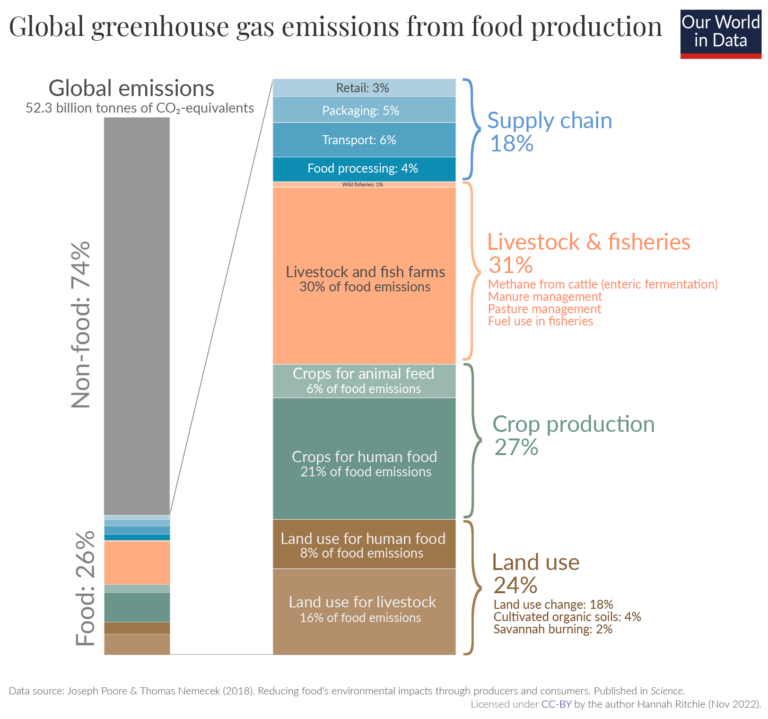Quellen
Verwendete Quellen
[1] https://ourworldindata.org/environmental-impacts-of-food?insight=food-emissions-climate-targets#key-insights-on-the-environmental-impacts-of-food “Food emissions could consume most of our 1.5°C carbon budget”
[51] https://www.science.org/doi/10.1126/science.aba7357 “Global food system emissions could preclude achieving the 1.5° and 2°C climate change targets | Science”
[2] https://ourworldindata.org/food-ghg-emissions
[3] https://ourworldindata.org/carbon-opportunity-costs-food#the-carbon-opportunity-costs-of-different-diets “How much could we reduce climate impacts through dietary change?”
[4] https://www.science.org/doi/10.1126/science.aaq0216 “Poore, J., und T. Nemecek. „Reducing food’s environmental impacts through producers and consumers“. Science 360, Nr. 6392 (Juni 2018): 987–92.”
[6] https://www.ipcc.ch/report/ar6/syr/downloads/report/IPCC_AR6_SYR_LongerReport.pdf “IPCC Bericht”
[7] https://www.fao.org/3/i3437e/i3437e.pdf “Tackling Climate Change through Livestock”
[8] https://ourworldindata.org/global-land-for-agriculture
[9] https://ourworldindata.org/land-use-diets “If everyone shifted to a plant-based diet we would reduce global land use for agriculture by 75%.”
[10] https://ourworldindata.org/carbon-opportunity-costs-food#dietary-changes-could-double-our-carbon-budget-for-1-5-c-but-it-s-no-substitute-for-getting-off-fossil-fuels “Dietary changes could double our carbon budget for 1.5°C – but it’s no substitute for getting off fossil fuels”
[11] https://ourworldindata.org/drivers-of-deforestation#beef-soy-and-palm-oil-are-responsible-for-60-of-tropical-deforestation “What are the sources of tropical Deforestation”
[12] https://ourworldindata.org/land-use-diets#livestock-waste-a-lot-of-energy-and-protein-but-do-produce-more-nutrient-dense-protein-sources “Livestock waste a lot of energy and protein”
[13] https://ourworldindata.org/land-use-diets#more-plant-based-diets-tend-to-need-less-cropland “More plant-based diets tend to need less cropland”
[14] https://www.sciencedirect.com/science/article/pii/S0195666321006267 “How do you know someone’s vegan? They won’t always tell you. An empirical test of the do-gooder’s dilemma”
[15] https://ourworldindata.org/carbon-opportunity-costs-food “What are the carbon opportunity costs of our food?”
[16] https://faunalytics.org/animal-ag-in-climate-media “Arévalo C, Splitter J, Anderson J: Animal Agriculture Is The Missing Piece In Climate Change Media Coverage. 2023”
[17] https://www.nature.com/articles/s43016-021-00431-5 “Dietary change in high-income nations alone can lead to substantial double climate dividend”
[18] https://journals.plos.org/climate/article?id=10.1371/journal.pclm.0000010 “Rapid global phaseout of animal agriculture has the potential to stabilize greenhouse gas levels for 30 years and offset 68 percent of CO2 emissions this century”
[19] https://www.umweltbundesamt.de/themen/wasser/grundwasser/nutzung-belastungen/faqs-zu-nitrat-im-grund-trinkwasser#was-ist-der-unterschied-zwischen-trinkwasser-rohwasser-und-grundwasser “umweltbundesamt: Nitrat im Grund- und Trinkwasser”
[20] https://documents1.worldbank.org/curated/en/758171468768828889/pdf/277150PAPER0wbwp0no1022.pdf “World Bank: Causes of Deforestation of the Brazilian Amazon”
[21] https://www.mpg.de/11663357/feinstaubbelastung-aus-duenger “Andrea Pozzer, Alexandra P. Tsimpidi, Vlassis A. Karydis, Alexander de Meij & Jos Lelieveld; Impact of agricultural emission reductions on fine particulate matter and public health; Atmos. Chem. Phys., 17, 12813–12826, 2017”
[22] https://www.mdpi.com/2071-1050/13/16/9251 “Industrial Animal Farming and Zoonotic Risk: COVID-19 as a Gateway to Sustainable Change? A Scoping Study”
[23] https://ourworldindata.org/grapher/energy-efficiency-of-meat-and-dairy-production “Energy efficiency of meat and dairy production”
[24] https://www.bund.net/massentierhaltung/antibiotika/ “Industrielle Tierhaltung braucht Antibiotika – und erhöht das Risiko resistenter Bakterien”
[25] https://albert-schweitzer-stiftung.de/themen/umwelt/biodiversitaet
[31] https://www.ncbi.nlm.nih.gov/pubmed/27886704 “Melina V, Craig W, Levin S. Position of the Academy of Nutrition and Dietetics: Vegetarian Diets. J Acad Nutr Diet. 2016;116(12):1970-1980.”
[32] https://www.ncbi.nlm.nih.gov/pmc/articles/PMC4993789/ “Pawlak R, Lester SE, Babatunde T. The prevalence of cobalamin deficiency among vegetarians assessed by serum vitamin B12: a review of literature. Eur J Clin Nutr. 2014;68(5):541-548.”
[33] https://www.ncbi.nlm.nih.gov/pmc/articles/PMC3723386/ “Alanne M, Kristiansson K, Auro K, Silander K, Kuulasmaa K, Peltonen L, Salomaa V, Perola M. Variation in the selenoprotein S gene locus is associated with coronary heart disease and ischemic stroke in two independent Finnish cohorts. Hum Genet. 2007;122(3-4):355-365.”
[34] https://www.ncbi.nlm.nih.gov/pmc/articles/PMC6470702/ “Lane K, Derbyshire E, Li W, Brennan C. Bioavailability and potential uses of vegetarian sources of omega-3 fatty acids: a review of the literature. Crit Rev Food Sci Nutr. 2014;54(5):572-579.”
[35] https://www.dge.de/wissenschaft/referenzwerte/protein/?L=0 “Position of the German Nutrition Society (DGE): Protein intake.”
[36] https://www.ncbi.nlm.nih.gov/books/NBK56060/ “Ross AC, Taylor CL, Yaktine AL, Del Valle HB. Dietary Reference Intakes for Calcium and Vitamin D. National Academies Press (US); 2011.”
[37] https://ods.od.nih.gov/factsheets/Iron-HealthProfessional/ “National Institutes of Health. Iron: Fact Sheet for Health Professionals.”
[38] https://www.ncbi.nlm.nih.gov/pmc/articles/PMC6367879/ “McKevith B. Nutritional aspects of cereals. Nutr Bull. 2004;29(2):111-142.”
[39] https://www.ncbi.nlm.nih.gov/books/NBK56068/ “Institute of Medicine (US) Panel on Macronutrients. Dietary Reference Intakes for Energy, Carbohydrate, Fiber, Fat, Fatty Acids, Cholesterol, Protein, and Amino Acids. Washington (DC): National Academies Press (US); 2005.”
[40] https://www.ncbi.nlm.nih.gov/pmc/articles/PMC6124841/ “Makki K, Deehan EC, Walter J, Bäckhed F. The Impact of Dietary Fiber on Gut Microbiota in Host Health and Disease. Cell Host Microbe. 2018;23(6):705-715.”
[50] https://theproof.com/what-you-need-to-know-about-omega-3-and-6-fats-philip-calder-phd/ “Philip Calder PhD, Simon Hill. What you need to know about omega 3 and 6 fats”
[55] https://de.wikipedia.org/wiki/Folgen_der_globalen_Erwärmung “Folgen der globalen Erwärmung. Wikipedia, 02.02.2020”
[56] https://www.umweltbundesamt.de/themen/ipcc-synthesebericht-macht-aktionsdruck-fuer-15degc “IPCC-Synthesebericht macht Aktionsdruck für 1,5°C noch deutlicher. Umweltbundesamt, 21.03.2023”
[57] https://www.bmu.de/fileadmin/Daten_BMU/Download_PDF/Klimaschutz/paris_abkommen_bf.pdf “Übereinkommen von Paris. Deutsches Umweltbundesamt, 14. Juni 2016”
[58] https://en.wikipedia.org/wiki/Merchants_of_Doubt “Merchants of Doubt: How a Handful of Scientists Obscured the Truth on Issues from Tobacco Smoke to Global Warming. Naomi Oreskes, Erik M. Conway. June 3, "
Linksammlung und Quellen
Dies ist eine lose Sammlung von interessanten Quellen.
Impact of Food
-
The Environmental impacts of food and agriculture
-
-
VOX Article: This is how much meat and dairy hurt the climate
-
Veganism is ‘single biggest way’ to reduce our environmental impact, study finds
-
Dietary change in high-income nations alone can lead to substantial double climate dividend
- switch to EAT Lancet
-
54 high-income nations representing 68% of global gross domestic product and 17% of population
-
such dietary change could reduce annual agricultural production emissions of high-income nations’ diets by 61%
-
sequestering as much as 98.3 (55.6–143.7) GtCO2 equivalent
-
This amount could potentially fulfil high-income nations’ future sum of carbon dioxide removal (CDR) obligations under the principle of equal per capita CDR responsibilities. Linking land, food, climate and public health policy will be vital to harnessing the opportunities of a double climate dividend.
-
How much could we reduce climate impacts through dietary change?

-
Half of the world’s habitable land is used for agriculture
-
Food emissions could consume most of our 1.5°C carbon budget

-
Carbon opportunity costs of our food

- If the world went vegan:
- 75% reduction of land used for agriculture
- 547Gt CO2 are stored regrowth of trees and wilderness
-

-
-
Livestock waste a lot of energy and protein, but do produce more nutrient-dense protein sources
Habitat Loss and Deforestation
Direct GHG Emissions
-
until 2100: 1356 Gt CO2
-
26% of global green house gas emissions
-
**at least 14.5%
- Original Source: 2006 Livestock’s long Shadow
- Controversy vs Wikipedia: Livestocks long Shadow, Controversy
- Later: Tackling Climate Change through Livestock
- 7.1 Gt per year, or 14,5% of all GHG emissions
- Very conservative!
- These are only direct emissions but the greatest potential are the Carbon Sequestration opportunities
- by activity
- 45% feed production and processing (this includes land use change)
- 39% enteric fermentation from ruminants
- 20% consumption of fossil fuel along supply chains (Cutting across all activities and all species)
- by livestock
- 65% Cattle, of which
- 41% are from beef, and
- 20% are from milk production
- Original Source: 2006 Livestock’s long Shadow
Human Carrying Capacity and World Hunger
Carrying capacity of U.S. agricultural land: Ten diet scenarios
Annual per capita land requirements ranged from 0.13 to 1.08 ha person-1 year-1 across the ten diet scenarios
(…) However, the carrying capacity of the vegan diet was lower than two of the healthy omnivore diet scenarios.
The Ocean
Human Health
-
Nutritional Benefits of Plant-Based Diets
-
Risks Associated with Meat Consumption
Future Projections
-
Feeding a Growing Population
-
Sustainability of Current Food Systems







